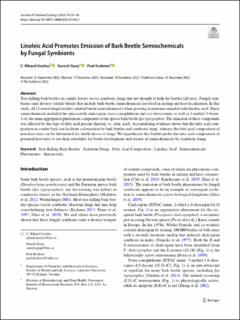| dc.contributor.author | Unelius, C. Rikard | |
| dc.contributor.author | Ganji, Suresh | |
| dc.contributor.author | Krokene, Paal | |
| dc.date.accessioned | 2023-03-13T19:34:58Z | |
| dc.date.available | 2023-03-13T19:34:58Z | |
| dc.date.created | 2023-01-13T13:09:43Z | |
| dc.date.issued | 2022-12-30 | |
| dc.identifier.citation | Journal of Chemical Ecology. 2022, . | en_US |
| dc.identifier.issn | 0098-0331 | |
| dc.identifier.uri | https://hdl.handle.net/11250/3058008 | |
| dc.description.abstract | Tree-killing bark beetles in conifer forests vector symbiotic fungi that are thought to help the beetles kill trees. Fungal symbionts emit diverse volatile blends that include bark beetle semiochemicals involved in mating and host localization. In this study, all 12 tested fungal isolates emitted beetle semiochemicals when growing in medium amended with linoleic acid. These semiochemicals included the spiroacetals chalcogran, trans-conophthorin and exo-brevicomin, as well as 2-methyl-3-buten-1-ol, the main aggregation pheromone component of the spruce bark beetle Ips typographus. The emission of these compounds was affected by the type of fatty acid present (linoleic vs. oleic acid). Accumulating evidence shows that the fatty acid composition in conifer bark can facilitate colonization by bark beetles and symbiotic fungi, whereas the fatty acid composition of non-host trees can be detrimental for beetle larvae or fungi. We hypothesize that beetles probe the fatty acid composition of potential host trees to test their suitability for beetle development and release of semiochemicals by symbiotic fungi. | en_US |
| dc.language.iso | eng | en_US |
| dc.publisher | Springer Nature | en_US |
| dc.rights | Navngivelse 4.0 Internasjonal | * |
| dc.rights.uri | http://creativecommons.org/licenses/by/4.0/deed.no | * |
| dc.title | Linoleic Acid Promotes Emission of Bark Beetle Semiochemicals by Fungal Symbionts | en_US |
| dc.title.alternative | Linoleic Acid Promotes Emission of Bark Beetle Semiochemicals by Fungal Symbionts | en_US |
| dc.type | Peer reviewed | en_US |
| dc.type | Journal article | en_US |
| dc.description.version | publishedVersion | en_US |
| dc.rights.holder | © The Author(s) 2022 | en_US |
| dc.source.pagenumber | 59-66 | en_US |
| dc.source.volume | 49 | en_US |
| dc.source.journal | Journal of Chemical Ecology | en_US |
| dc.identifier.doi | 10.1007/s10886-022-01400-3 | |
| dc.identifier.cristin | 2106569 | |
| cristin.ispublished | true | |
| cristin.fulltext | original | |
| cristin.qualitycode | 1 | |

